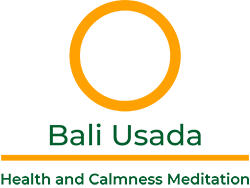The meditation that I’ve done over the years that are included within your system are mindfulness and breathing. But I’ve to say that Mr. Merta Ada has introduced a somewhat different way of doing mindfulness and breathing from that which I’m acquainted with, in such a traditional way we practice. We focus the attention either in the nostrils or on the upper lips wherever one feels the impact of the breath. But Merta Ada has introduced a quite interesting – and I found it very useful variation-of focusing the attention inside the nostrils at the point where one feels the contact with the inner part of the nose. And it actually gives a very powerful impression, which serves as a strong basis for concentration.
The other meditation which I’ve done for the years in somewhat different way, is the meditation on the parts of the body. So, in the classical buddhist tradition, we have a selection of 32 parts, which are not arranged very systematically, not in account with the modern physiology. So Merta Ada has expanded the list of parts to contemplate and has arranged it in a much more-I have to say- much more scientific way by proceeding from the grosser, harder part of the body, to the subtler, finer part of the body. This past September in Singapore, I learn from Mr. Burg the meditation on the 4 elements, actually this is the meditation which comes down on the classical Buddhist tradition, but it’s very rarely practiced these days. For it is practiced in some of the rather superficial way, but I found from the instructions of Burg in Singapore , and also from Merta Ada instruction here, that we do it in very very deep, very thorough and very systematically.
The meditation, which we were completely new to me when I have to say that I wasn’t able to say that I wasn’t able to do it all, that is the Meridian meditation. I think Merta Ada has told you, I suffered for many-many years from a chronic headache condition and sometimes my condition becomes so severe that I find to be, if sitting in my back
I find it to be, a major part just to get up take a glass of water or to go to the bath room…(laugh). So, on that particular day when the meridian meditation was taught, I was such a condition, but I always take it as a principal never to give up and always to fight back…(laugh).
So I came up to the next stage meditation with Chakra meditation, which is also completely new to me as a practice, I read about the Chakra meditation in books on yoga, but it always presented as something which is to be done by a very high yogis living in the Himalayas. But Merta Ada made it very intelligible, very practicable. And I have to say, I found it very very beneficial and very-actually-inspiring and very useful.
The Metta meditation, also I have to say, I have done many-many times over the years. I mean I’ve done it as a regular practice over the years, and Merta Ada teaches it in a very classical way. In fact, he bases his method on the classical Theravada and Buddhist Meditation Manual of Visuddhi Magga, taking the groups, via groups, oneself, family or respected teachers, close friends, neutral people, enemy.
I think this is very-very beneficial meditation for ending the retreat for putting on the last day, so it serves to integrate the practitioner after you’ve been plunging into the depth of your body, to your inner psychic and physical experience for all of these days, now the Metta meditation acts as a kind of bridge for coming back into the world.
And now, as I said Merta Ada has taken many different types of meditations from 4-5 techniques from the Buddhist, Classical Buddhist tradition; the Meridian meditation is from Chinese and Balinese Health theory; and the Chakra meditation is from the Indian Yoga tradition. And he has integrated them into a system, which he is presenting as a way to physical health. But also as he emphasizes many times, the main purpose really in developing this meditation, and even developing physical health is to be able to develop the harmonious mind. I think really this is may be the most important lesson that we should learn, that the body might be healthy or unhealthy, it might become fell and sick, and it might be vigorous and strong. But no matter what the condition of the body is, the most important thing is to keep the mind free from affliction by – you called the winds of defilement: by the thoughts of pride and self-glorification when the body is strong, by the thoughts of sorrow, depression when the body is sick and weak.
I’d say I’ve mentioned that I’ve been afflicted by this physical condition, this headache condition, sometimes I get a little upset, but maybe I can congratulate myself that generally I maintain an attitude of a complete, fairly complete equanimity towards it, I just try to look at the body as being something we say (in Pali language) it’s not mine, not I, not myself, not something that we should identify with. And so, the most important thing in practicing this meditation is to be able to develop the harmonious mind, the mind which is balance, poise, free from attachment, free from aversion, free from sorrow, free from illation.
If I were to present what might be taken as criticism, it seems to me that to really experience this meditation in the full capacity, one needs a period of about 3 months..(laugh..), the exotic course to be spread out of something like 3 months.
In Buddhism we speak of 4 types of people;
Those who make easy progress and have quick comprehension,
Those who make easy progress and have slow comprehension,
Those who make difficult progress and have quick comprehension,
Those who make difficult progress and have slow comprehension.
It seems the course compressed into 10 days is best suited for those who make easy progress and have quick comprehension. But some of us, myself included, would fit into category of those who make difficult progress and have slow comprehension. And so it seems that- I mean, one experiences very tangible concrete benefits from the meditation – but to really sort of plunge into this meditation and to immerse oneself in attempt to fable-myths full potential, each technique in itself could be extended for over a month, or several months.
, I have to – perhaps in closing – just express my appreciation and gratitude towards Merta Ada and also Burg who has spent myself a very good friend and very strong source of support. I happened to come to learn about Merta Ada, from 2 streams that came quite independently, but just crystallized at the same time. First from my friend in Singapore, Dr. Why Chung, he told me that Burg will be coming to Singapore at the end of September and that he will be getting and 8 day course, and he suggested that I attend it. Then I just read a little description about Burg, his background, and it mentioned that he has learned meditation – this Usada meditation – for several years under an Indonesian healer in Bali named Merta Ada. Then about a week later, I got an e-mail from close friend, a French monk, Ven. Titinnanno, telling me that he had just come from Bali and practicing meditation under Merta Ada, and suggested that I come to practice with him and he even offered to cover my airfare to Bali and back. So, in closing I would just have to also express my appreciation to Ven. Titinnanno, who made this course possible for me.
Bhikku Bodhi
Testimony Tapa Brata Usada II – Pacung 6th – 17 th January 2002

